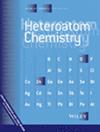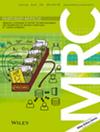期刊缩写:
Heteroat. Chem
影响因子:
1.4
ISSN:
print: 1042-7163
on-line: 1098-1071
on-line: 1098-1071
研究领域:
化学-化学综合
创刊年份:
1990年
h-index:
38
自引率:
0.00%
Gold OA文章占比:
100.00%
原创研究文献占比:
80.00%
SCI收录类型:
Science Citation Index Expanded (SCIE) || Scopus (CiteScore) || Directory of Open Access Journals (DOAJ)
期刊介绍英文:
Heteroatom Chemistry brings together a broad, interdisciplinary group of chemists who work with compounds containing main-group elements of groups 13 through 17 of the Periodic Table, and certain other related elements. The fundamental reactivity under investigation should, in all cases, be concentrated about the heteroatoms. It does not matter whether the compounds being studied are acyclic or cyclic; saturated or unsaturated; monomeric, polymeric or solid state in nature; inorganic, organic, or naturally occurring, so long as the heteroatom is playing an essential role. Computational, experimental, and combined studies are equally welcome.
Subject areas include (but are by no means limited to):
-Reactivity about heteroatoms for accessing new products or synthetic pathways
-Unusual valency main-group element compounds and their properties
-Highly strained (e.g. bridged) main-group element compounds and their properties
-Photochemical or thermal cleavage of heteroatom bonds and the resulting reactivity
-Uncommon and structurally interesting heteroatom-containing species (including those containing multiple bonds and catenation)
-Stereochemistry of compounds due to the presence of heteroatoms
-Neighboring group effects of heteroatoms on the properties of compounds
-Main-group element compounds as analogues of transition metal compounds
-Variations and new results from established and named reactions (including Wittig, Kabachnik–Fields, Pudovik, Arbuzov, Hirao, and Mitsunobu)
-Catalysis and green syntheses enabled by heteroatoms and their chemistry
-Applications of compounds where the heteroatom plays a critical role.
In addition to original research articles on heteroatom chemistry, the journal welcomes focused review articles that examine the state of the art, identify emerging trends, and suggest future directions for developing fields.
CiteScore:
| CiteScore | SJR | SNIP | CiteScore排名 |
|---|---|---|---|
| 1.2 | 0.167 | 0.407 | 学科 排名 百分位 大类:Chemistry 小类:General Chemistry 319 / 408 21% |
发文信息
中科院SCI期刊分区
2025年3月20日发布
| 大类 | 小类 | TOP期刊 | 综述期刊 |
|---|---|---|---|
| 4区 化学 | 4区 化学:综合 CHEMISTRY, MULTIDISCIPLINARY | 否 | 否 |
2023年12月发布
| 大类 | 小类 | TOP期刊 | 综述期刊 |
|---|---|---|---|
| 4区 化学 |
4区
化学:综合
CHEMISTRY, MULTIDISCIPLINARY
|
否 | 否 |
WOS期刊分区
| 学科分类 |
|---|
Q3CHEMISTRY, MULTIDISCIPLINARY |
历年影响因子
| 2015年 | 1.2030 |
|---|---|
| 2016年 | 1.2210 |
| 2017年 | 1.1370 |
| 2018年 | 1.0110 |
| 2019年 | 0.8620 |
| 2020年 | 1.3660 |
| 2021年 | 1.4800 |
| 2022年 | 0.3000 |
| 2023年 | 1.1000 |
| 2024年 | 1.4000 |
历年发表
| 2012年 | 76 |
|---|---|
| 2013年 | 70 |
| 2014年 | 112 |
| 2015年 | 54 |
| 2016年 | 82 |
| 2017年 | 65 |
| 2018年 | 81 |
| 2019年 | 19 |
| 2020年 | 7 |
| 2021年 | 2 |
| 2022年 | 5 |
投稿信息
出版周期:
Bimonthly
出版语言:
English
出版国家(地区):
UNITED STATES
审稿时长:
6 months
出版商:
Wiley-Blackwell
编辑部地址:
JOHN WILEY & SONS INC, 111 RIVER ST, HOBOKEN, USA, NJ, 07030
Heteroatom Chemistry - 最新文献
CuI/PPA-Catalyzed Synthesis of Novel Sulfur-Containing Quinoline Isosteres: In Silico and DFT Analyses
Pub Date : 2025-07-28 DOI: 10.1155/hc/9933732 Kolandaivel Prabha, Satheeshkumar Rajendran, Gamze Tüzün, Kailasam Saravana Mani, Koray SayinAnticancer and Antimicrobial Activity of Some New 2,3-Dihydro-1,5-benzodiazepine Derivatives
Pub Date : 2023-11-06 DOI: 10.1155/2023/3390122 Felix Odame, Tatenda Madanhire, Clement Tettey, David Neglo, Francisca Adzaho, Daniel Sedohia, Eric C. HostenNovel Thioethers of Dihydroartemisinin Exhibiting Their Biological Activities
Pub Date : 2023-02-09 DOI: 10.1155/2023/6761186 Ngoc Hung Truong, Thi Hong Ha Tran, Kim Chi Hoang, Duc Bao Ninh, Viet Duc Le, Duc Anh Le, Van Chinh Luu
免责声明:
本页显示期刊或杂志信息,仅供参考学习,不是任何期刊杂志官网,不涉及出版事务,特此申明。如需出版一切事务需要用户自己向出版商联系核实。若本页展示内容有任何问题,请联系我们,邮箱:info@booksci.cn,我们会认真核实处理。
本页显示期刊或杂志信息,仅供参考学习,不是任何期刊杂志官网,不涉及出版事务,特此申明。如需出版一切事务需要用户自己向出版商联系核实。若本页展示内容有任何问题,请联系我们,邮箱:info@booksci.cn,我们会认真核实处理。








